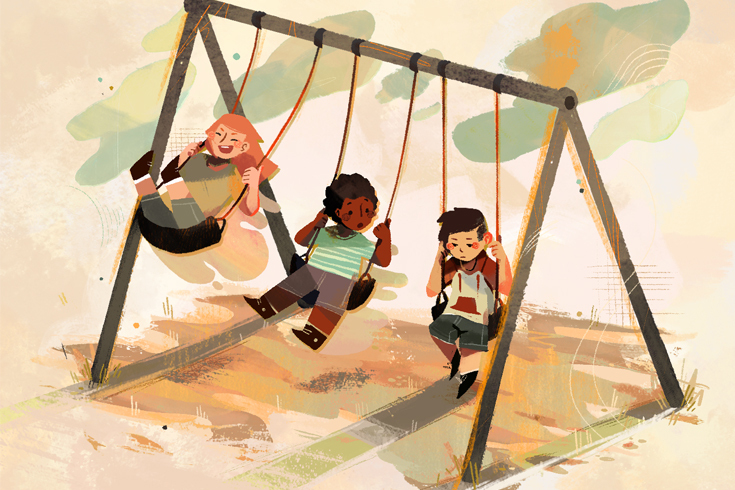The paramedics radioed in the details to the rural Ontario hospital: female teenager, intentional overdose, ETA five minutes. The patient’s mother arrived with her, wearing a look I had grown all too familiar with—bewilderment, incredulity, fear. When I’d taken the job as an emergency-department clerk, I’d steeled myself for blood and guts, for car accidents and broken bones. But I wasn’t prepared for the sheer number of cases like this one.
After the girl was out of medical danger, the emergency physician asked me to contact the attending psychiatrist, who would speak with the girl and try to find out what had triggered her suicide attempt. Beyond this consultation, however, the patient and her family would be largely on their own, left to navigate a fragmented
system that has allowed too many young people to fall through the cracks.
Last June, researchers from the Children’s Hospital of Eastern Ontario, the University of Ottawa, and McGill University released a study about emergency-department visits by Ontario adolescents between 2003 and 2017. Beginning in 2009, the number of adolescents presenting for self-harm increased sharply, more than doubling between then and 2017. Visits for mental health issues, such as anxiety, depression, and suicidal ideation, rose 78 percent over the same eight-year period. Mental health professionals report children as young as seven or eight expressing a desire to take their own lives.
Across the country, the situation is similarly dire. In BC, almost one in five of the province’s students reported having seriously considered suicide in the past year, according to a survey by the youth-health nonprofit McCreary Centre Society. And, according to Judy Darcy, BC’s minister of mental health and addictions, Indigenous youth in the province are dying of suicide at a rate four to five times higher than their non-Indigenous peers.
Dina Kulik, a Toronto pediatrician, experiences the youth mental health crisis first-hand during every emergency-department shift she works. Her caseload regularly includes children whose parents have just discovered fresh cuts on their arms, young people escorted by police after sending suicidal texts and barricading their bedrooms, or unconscious teens wheeled in by ambulance crews after intentionally overdosing on prescription medication.
When she isn’t working in the emergency department, Kulik runs a primary-care and consulting practice at Kidcrew, a multispecialty pediatric clinic, where she discovers still more young people wrestling with suicidal thoughts. Each visit, patients are given a questionnaire that looks at many different aspects of their lives, including mental health, bullying, and overall safety. “It’s eye-opening,” says Kulik of the survey results. “The vast majority of the parents bringing these kids have no idea their kid is struggling. They never heard the child complain.”
There are many other young people struggling with suicidality who do not seek emergency care or share their mental state with physicians—meaning they’re missed in studies, which often focus on emergency-room visits and inpatient admissions. According to Katherine Hay, president and CEO of Kids Help Phone—which collects real-time data on youth suicidality across Canada—the number of young people calling to seek help for suicidal thoughts has increased by 110 percent over the past four years. Hay estimates that her team intervenes in an average of eight adolescent suicide attempts per day.
It’s a crisis that has overwhelmed the tenuous mental health supports available to most Canadians, and as it shows no sign of stopping, the rest of us are struggling to understand why. Why would someone so young want to take their own life? And why are more adolescents reaching this point now than ever before? “There is an underlying emotional need that isn’t getting met,” says Jennifer Russel, a psychiatrist at BC Children’s Hospital. “We need to figure out what that need is and how to meet it.”
There was a feeling in the emergency department, after cases like this one, that was difficult to describe—a kind of collective exhaustion. When we were able to talk about it, we tried in vain to make sense of it. I was new to the department, but a long-time nurse told me it hadn’t always been like this. Something had changed, something was getting worse. But what?
According to Rob Billard, a social worker and former youth crisis worker, it has become more common for children to be indiscriminately exposed to distressing news from around the globe.“It’s not the children that are different now—it’s the society,” he says. “Today’s tech exposes young ones to information in a challenging way. They get close to subjects that are quite adult-like without an adult to discuss them with. We’re leaving young people to their own devices to deal with really heavy stuff.”
The climate emergency is a prime example of world affairs fuelling angst among young people. They understand how their future is synonymous with the future of the planet, and they see the complacency of the leaders and corporations complicit in its ruination. For the Greta Thunbergs among them, this leads to activism. But the more that student protests and youth organizing take place without meaningfully shifting political and economic realities, the deeper adolescent hopelessness may become.
Another factor that can cause youth mental health crises to spike is their tendency to spread among peer groups. In the wake of Saskatchewan’s 2018 Humboldt Broncos bus crash, Kids Help Phone experienced a cascade of calls from adolescents across the Prairies seeking support for the destabilization of grief and loss, and the organization’s stats show ripple effects continuing for over a year afterward. In the summer of 2018, in Nunavut, another region-wide crisis unfolded as twelve young people tried to take their own lives. “We get calls from some Indigenous youths where four, five, or six of their friends have died by suicide,” says Hay. “It’s contagious.”
Periods of economic hardship or general anxiety also take their toll. Recently, Hay noted that the number of adolescents reaching out to Kids Help Phone had increased by 38 percent between 2017 and 2018 in Alberta. “When we dug into the issues, we tied that to economic concerns happening at the time,” she says. “If families are in strife due to unemployment or financial strains, the entire family is in strife. Kids do not exist in a vacuum.” Hay also notes that, during the pandemic, the number of adolescents reaching out for help across the country has been nearly double what it was over the same period last year.
Isolation can exacerbate all kinds of mental health issues, and—even in nonpandemic times—adolescents are in some ways more isolated now than ever. Russel, of BC Children’s Hospital, says the increased prevalence of smartphone use has changed the quality of young people’s relationships. “Being alone in your room on social media might be the loneliest thing for teenagers,” she says. She contrasts this state of affairs with that of her own childhood: when friends or classmates called, it would have likely been on a family line. Now, if their child has an upsetting interaction, parents often aren’t aware of it. Friendship spats, relationship breakups, even public humiliation—it all happens behind closed doors, on the backlit screens that dominate young people’s attention.
A glimmer of hope in the rising numbers of young people coming forward with mental health issues is that it’s becoming less stigmatized to do so. “Numbers are rising because mental health is becoming more recognized,” BC minister Judy Darcy told me. “They are learning that it is okay that they are not okay.” But it’s unlikely that destigmatization can account for the entire statistical leap, and regardless, a health care system able to support every adolescent experiencing mental illness is long overdue.
When children express suicidal thoughts, the knee-jerk reaction of many adults is to head to the closest emergency department. But some parents I met in the emergency department had been struggling to find a way into the mental health system for a while and came to us as a last resort. While emergency departments may be the only choice in some cases, many people are stunned at how few resources are available once they arrive. More than once, I witnessed desperate parents yelling at staff about the lack of treatment options available for their child. One mother scoffed that their visit was nothing more than an exercise in filling out forms.
Unless a hospital is in a major city, it’s unlikely to have a pediatric psychiatrist, and emergency staff are not specially trained in pediatric mental health. Some hospitals are experimenting with telepsychiatry programs, in which an on-call pediatric psychiatrist will assess and counsel youth via video chat, but these programs are often available only during the day. Overnight—which is when Kids Help Phone reports a surge of distressed callers—hospitals in smaller cities or rural areas typically have only an emergency physician, who can often do little more than make outpatient referrals (the first step in a treatment-seeking process that can take many months). In severe cases, they can arrange an ambulance transfer to the closest pediatric hospital for psychiatric admission. (Due to safety concerns, adolescents are generally not admitted to adult psychiatric units.)
Back out in the community, bewildered parents are left on their own to navigate a complex, patchwork system. “It’s embarrassing,” says Kulik of the state of Ontario’s mental health care. Among the most common obstacles are a lack of child psychiatrists accepting new patients, a shortage of doctors to prescribe and renew medications, and excessive wait times for outpatient programs.
While there’s a long way to go before this crisis is under control, some health care providers are making progress. In 2018, BC Children’s Hospital launched Compass, a program that provides remote clinical support to pediatricians, mental health care providers, primary care physicians, and nurses throughout BC and in parts of the Yukon. The Compass team has so far assisted with over 1,800 cases, and Russel, its clinical director, estimates that, over the past year, they’ve successfully averted twenty hospital transfers, which would have involved sedating and in some cases intubating patients in order to fly them elsewhere for a higher level of care. In a country like Canada—one of large, sparsely populated regions and many remote communities—Compass could represent a way to extend the best care possible to as much of the country as possible. For the time being, however, programs of its kind are few and far between.
Broadening the coverage of mental health resources is certainly desirable, but it doesn’t represent a complete solution: interpersonal relationships are key. The presence of just one supportive adult—a parent, an extended family member, a coach, a guidance counsellor—can be a major determinant of how well a child copes with stress.
And, even if a young person’s mental health issues escalate to the point of requiring clinical care, Russel wants parents to know that the situation is never hopeless. “Just because your child has depression or is feeling suicidal at fifteen, that does not mean their future is doomed,” she says. “It’s like if your child is struggling with math. It does not mean they will struggle their whole lives.”
I no longer work in the emergency department, and I don’t know where any of the young people I met in their darkest moments are today. But I’ll never forget them or the crisis they opened my eyes to. One reason each of them reached the point they did seems to have been how difficult their situations were to talk about, how strong our collective urge can be to look away. I’m looking now, and I’m talking now, and the rest of us should too.





